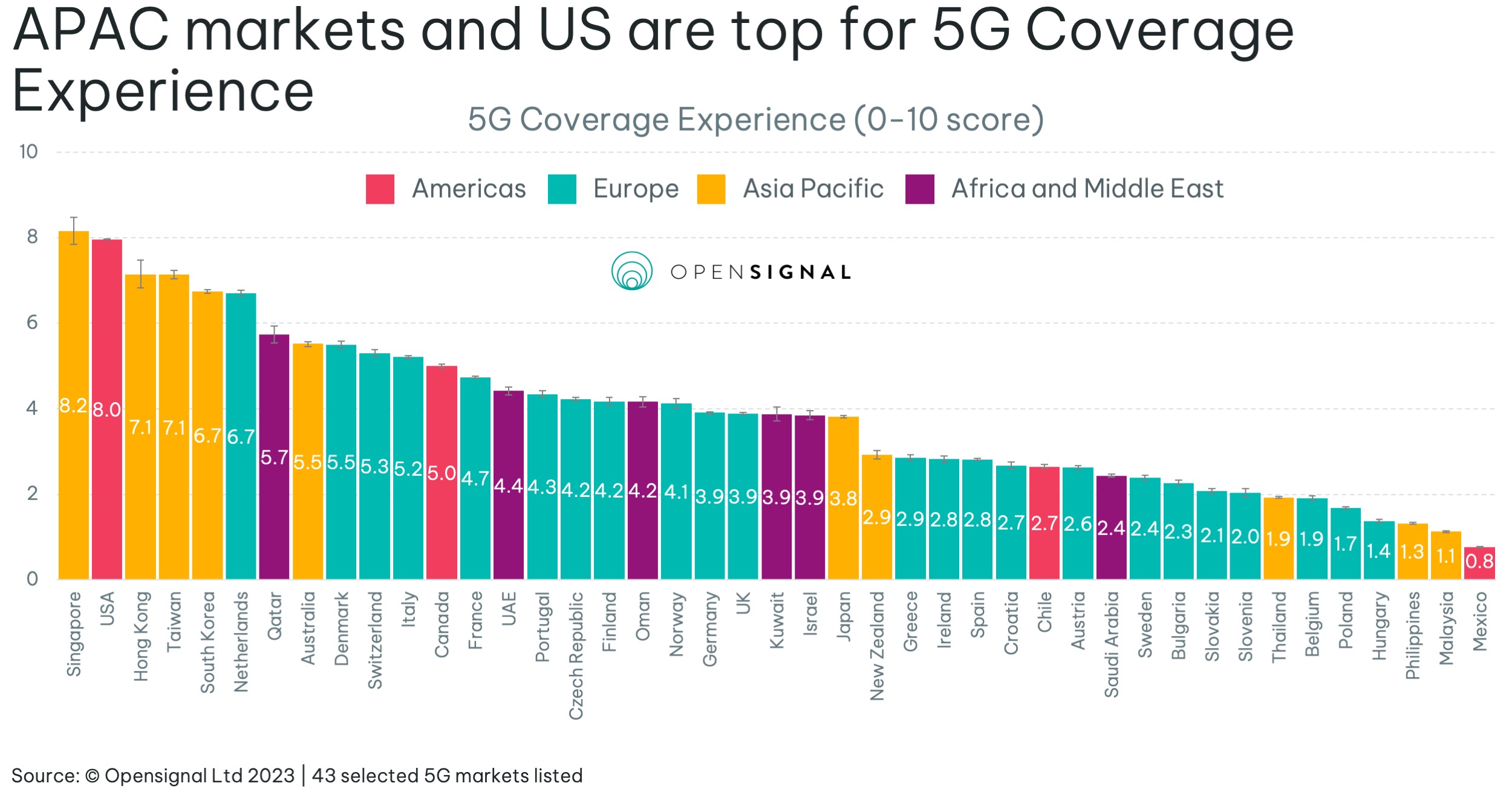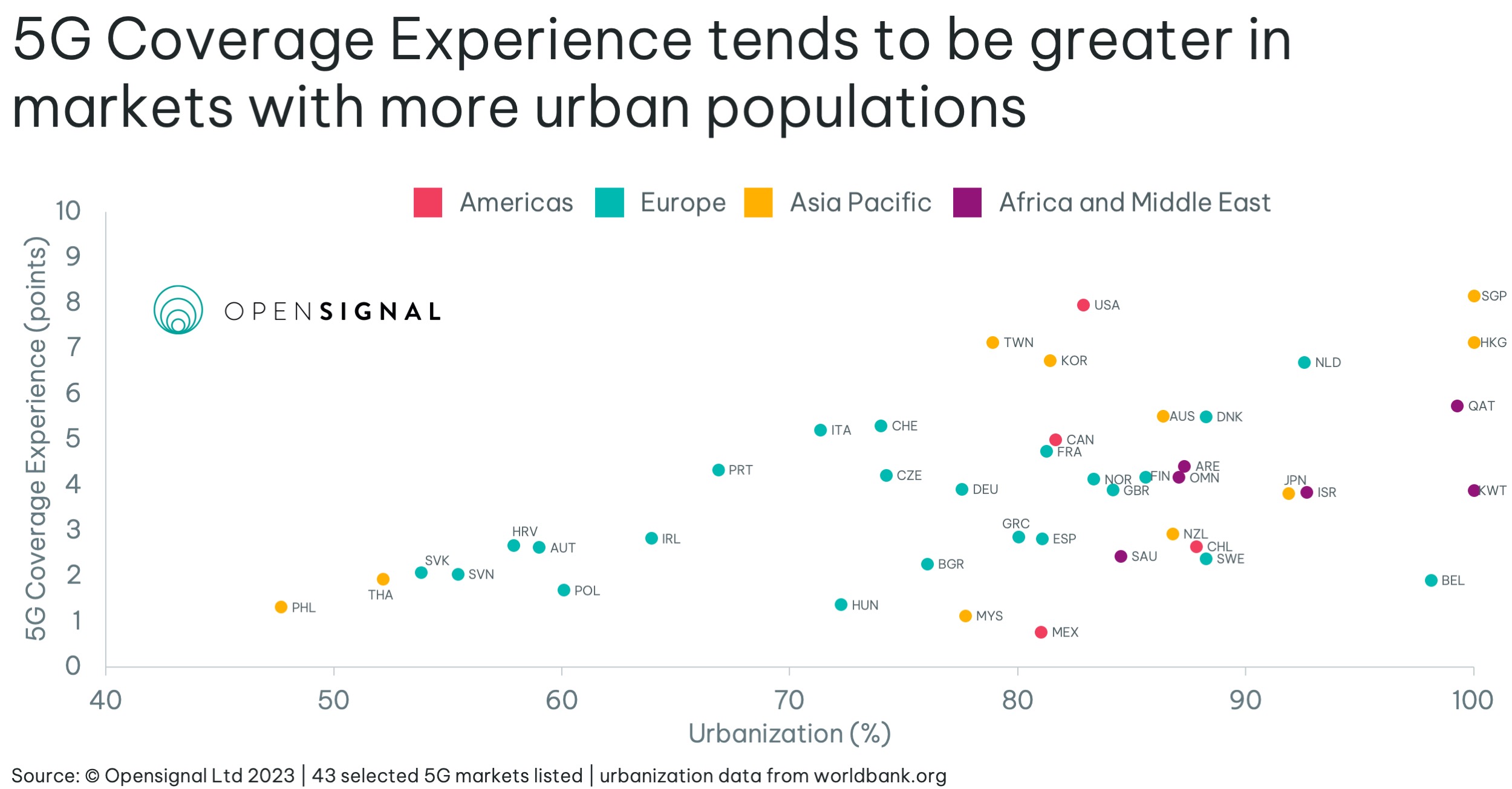Opensignal Coverage Experience
Opensignal’s new Coverage Experience metric finds Singapore #1 in 5G
Opensignal is now measuring coverage experience to track 5G network quality. Their analysts believe coverage more accurately reflects users’ expectations and experience. Opensignal’s new Coverage Experience metric measures the geographic coverage of populated areas on a 10-point scale to represent the experience users receive as they travel around areas where they would reasonably expect to find coverage. The new Coverage Experience metric completes the picture of how expansive a market’s coverage is, along with the coverage experienced by our users on each national operator within the market.
Singapore, which rolled out 5G two years after the USA, is now on par in offering the world’s best experience – both countries rate a 10. In Singapore, Singtel rates 7.9, StarHub 7.1, and M1 7.0 out of 10.

South Korea and the USA score relatively high for 5G Coverage Experience — with the USA statistically tying for the top spot with Singapore. This is due to, in part, more widespread deployments of 5G in the USA on low frequency bands, enabling greater geographic reach compared to many other markets with large land areas.
Hong Kong, Taiwan, South Korea and the Netherlands round out the leaderboard.
Some telcos have opened up a massive lead over their competitors. Australia’s Telstra rates 5.2 points out of 10, almost double both of its rivals. In Japan, NTT Docomo scores 3.3, while newcomer Rakuten (which has just signed a 5G roaming agreement with KDDI) is just 0.4. In Europe, Belgium scores just 1.9, while Sweden, Austria, Spain, Greece and Ireland all tally below 3 points.

A higher percentage of urbanization in a market means that — all else being equal — operators are able to serve proportionally more users with the same number of base stations, which reflects in higher 5G Coverage Experience across such markets. The graph above shows that the score increases along with urbanization percentage, with markets below 65% struggling to score above three points.
Some markets such as Singapore and Hong Kong have nearly 100% of their population living in urban areas. This greatly benefits them when it comes to rolling out infrastructure for 5G. Singapore launched 5G two years after the USA and South Korea, yet it ranks joint first for 5G Coverage Experience.
Coverage is an important metric as it quantifies the extent to which users will be able to use their network in their home market. Opensignal’s new Coverage Experience metric represents the real-world experience users receive as they travel around areas where they would reasonably expect to find coverage.
……………………………………………………………………………………………………………………………………………………..
Robert Clark of Light Reading wrote:
he one shortcoming of the 5G survey is the lack of data from India and China, the Asian giants who by their size are among the biggest drivers of global 5G. India’s absence is understandable as it’s still a nascent 5G market. In the case of China, where not even domestic organizations are allowed to track network performance, it’s hardly a surprise that foreign research efforts are blocked as well.
Chinese telcos and the Ministry for Industry and IT are barely any more informative. Their favored metric is base station population, which reveals nothing about user or geographic reach.
Right now China’s base station total, which is faithfully tallied up monthly, is 2.38 million – supposedly representing more than 60% of the global number. China Mobile and the China Telecom-Unicom partnership account for roughly half each.
The fact that some 600 million customers have signed up for China 5G may suggest they are happy enough with their user experience. On the other hand, that another 600 million have become ‘5G customers’ while remaining on the 4G network may indicate that they think 5G is simply better value.
References:
https://www.opensignal.com/2023/05/17/understanding-5g-and-overall-coverage-worldwide
https://cdn.opensignal.com/public/202305_coverage_operators_charts_5g_0.pdf


